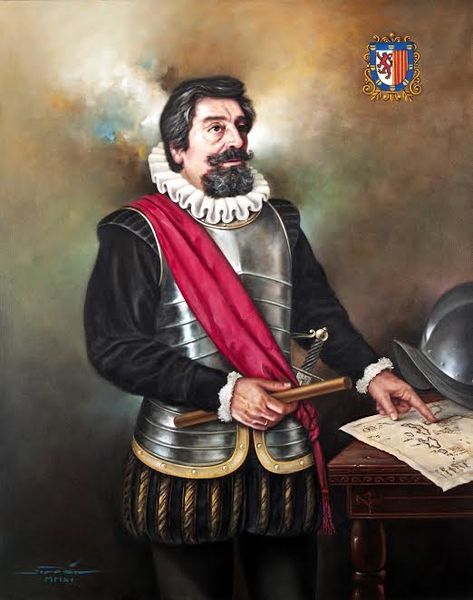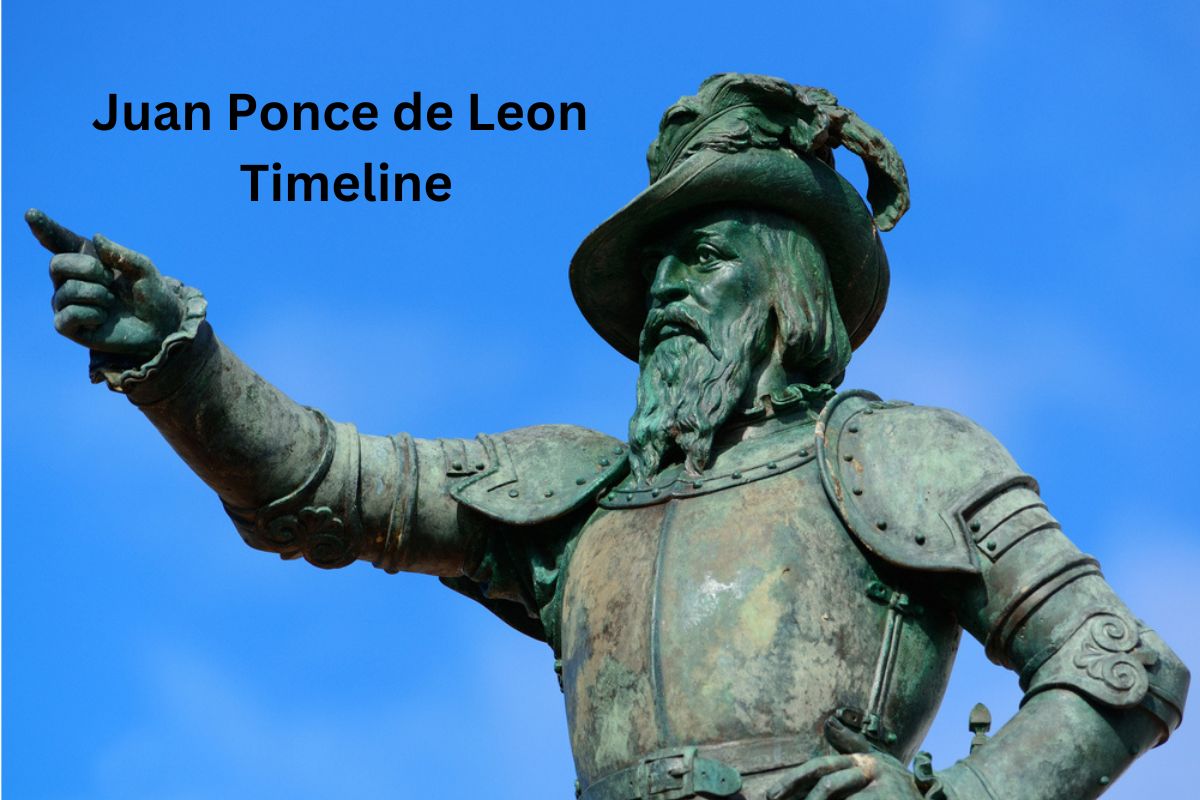Juan Ponce de León was a Spanish explorer and conquistador known for his explorations of the Caribbean and Florida. He was born around 1460 in Santervás de Campos, Valladolid, Spain. Ponce de León first came to the Americas as part of Christopher Columbus’s second expedition in 1493.
In the New World, he initially served as a military officer and was later appointed as the governor of the eastern province of Hispaniola. In 1508-1509, he led an expedition to the island now known as Puerto Rico and was appointed its governor.
Ponce de León is best known for his 1513 expedition to Florida, which he named. He is often associated with the legend of the Fountain of Youth, a mythical spring that grants eternal youth to those who drink from it.
Although it’s uncertain whether he truly sought the Fountain, it’s clear that his explorations significantly expanded European knowledge of the New World.
In 1521, he returned to Florida with the intent of establishing a colony. However, the expedition was met with resistance from indigenous people, and Ponce de León was injured.
He died later that year from his wound. His exploration efforts left a lasting legacy and paved the way for further Spanish exploration and colonization in the Americas.
| Year | Event |
|---|---|
| 1460 | Juan Ponce de León is born, likely in Santervás de Campos, Valladolid, Spain. |
| 1493 | Sails to the New World on Christopher Columbus’s second expedition. |
| 1502 | Is appointed governor of the eastern province of Hispaniola (now the Dominican Republic) by Nicolás de Ovando. |
| 1504 | Crushes a rebellion of the indigenous Tainos people. |
| 1508-1509 | Leads an expedition to the island of San Juan Bautista (now Puerto Rico) and establishes a successful colony. |
| 1511 | Is removed as governor of Puerto Rico by Diego Columbus, son of Christopher Columbus. |
| 1512 | Receives authorization from King Ferdinand to explore the northern islands and search for Bimini, the supposed location of the Fountain of Youth. |
| 1513 | In April, sights the east coast of Florida and claims it for Spain, believing it to be an island and naming it “La Florida”. |
| 1514 | Is named military governor of Bimini and Florida, with permission to colonize the region. |
| 1521 | Returns to Florida to establish a colony but his expedition is attacked by native people, and he is injured. |
| 1521 (July) | Dies in Cuba from the wound he received in Florida. |
Timeline of Juan Ponce de Leon
1460 – Birth
Juan Ponce de León is believed to have been born in 1460, though the exact date is not known. His birthplace is generally considered to be the village of Santervás de Campos in the province of Valladolid, Spain. Little is known about his early life, including his family and education.
However, it is likely that he came from a noble family, and he may have been page at the royal court of Aragon, which would have provided him with an education.

1493 – Columbus’s Second Voyage
Ponce de León is known to have joined Christopher Columbus on his second voyage to the New World in 1493. The Spanish monarchs, Ferdinand and Isabella, funded this expedition following Columbus’s successful voyage in 1492.
On this second voyage, Columbus and his crew founded the first Spanish colony in the New World, La Isabela, on the island of Hispaniola.
Ponce de León’s exact role in the expedition is not known, but he likely served as a soldier and was able to gain some valuable experience in colonial administration and exploration.
1502 – Governor of Eastern Hispaniola
Ponce de León’s administrative skills and experience led to his appointment as governor of the eastern province of Hispaniola (modern-day Dominican Republic) by Nicolás de Ovando, the governor of Hispaniola, in 1502.
This province was largely undeveloped and Ponce de León was responsible for its economic development and for maintaining order between the Spanish settlers and the indigenous Taino people.
His appointment as governor was likely a recognition of his contributions to the Spanish colonial enterprise in the New World.
1504 – Crushing of Taino Rebellion
As the governor of the eastern province of Hispaniola, Ponce de León had to deal with unrest among the indigenous Taino population. In 1504, this culminated in a rebellion.
Ponce de León, with his military background, successfully suppressed this rebellion, ensuring the survival of the Spanish colony and further solidifying his reputation as an effective military leader.
However, the treatment of the Tainos was often brutal, which led to criticism from some quarters, particularly from the clergy.
1508-1509 – Expedition to Puerto Rico
In 1508, Ponce de León led an expedition to the island of San Juan Bautista, now known as Puerto Rico. He had heard rumors of gold on the island and, with the permission of the Spanish Crown, set out to find it.
His expedition was successful in establishing a colony and in finding significant gold deposits, leading to a “gold rush” of sorts. In 1509, he was appointed governor of the island by King Ferdinand.
1511 – Removal as Governor of Puerto Rico
Ponce de León’s time as governor of Puerto Rico was relatively short. In 1511, Diego Columbus, the son of Christopher Columbus, won a legal battle affirming his father’s rights to the governance of the New World territories. As a result, Ponce de León was removed from his post as governor of Puerto Rico.
1512 – Search for Bimini
Despite his removal from the governorship, Ponce de León’s exploratory endeavors continued. In 1512, he received royal permission from King Ferdinand to explore the northern islands and search for the legendary island of Bimini, where the Fountain of Youth was said to be located.
The Fountain of Youth was a legendary spring that supposedly restored the youth of anyone who drank from it. While it’s debated whether Ponce de León actually believed in the existence of the Fountain, his search for Bimini and other northern islands furthered European knowledge of the New World.

1513 – Discovery of Florida
On April 2, 1513, Ponce de León sighted land, which he believed to be another island. He named it “La Florida” in honor of the Spanish feast of flowers, Pascua Florida. He claimed this land for Spain.
Notably, Ponce de León was the first recorded European to set foot on what is now the continental United States. He and his crew explored the northeast coast of Florida and the Florida Keys, continuing to believe they were islands.
1514 – Military Governor of Bimini and Florida
Following his expedition, Ponce de León was named the military governor of Bimini and Florida in 1514, and he was given the right to colonize these regions. It is important to note that the Spanish Crown often granted such titles and privileges as rewards for services to the crown.
Ponce de León’s appointment to this position was likely a recognition of his contributions to Spanish exploration and the expansion of Spain’s territories in the New World.
1521 – Return to Florida
In 1521, Ponce de León returned to Florida with the intent of establishing a colony. He brought with him two ships and 200 people, including farmers and craftsmen.
However, soon after their arrival, the group was attacked by native people. In the ensuing conflict, Ponce de León was wounded by an arrow.
1521 (July) – Death
Ponce de León died in July 1521 in Havana, Cuba, as a result of the wound he received in Florida. His body was later transported to Puerto Rico and interred in San Juan Cathedral. His exploration and colonization efforts helped pave the way for further Spanish exploration and conquest in the New World, and he is often remembered today for his search for the mythical Fountain of Youth, which continues to capture the public’s imagination.
